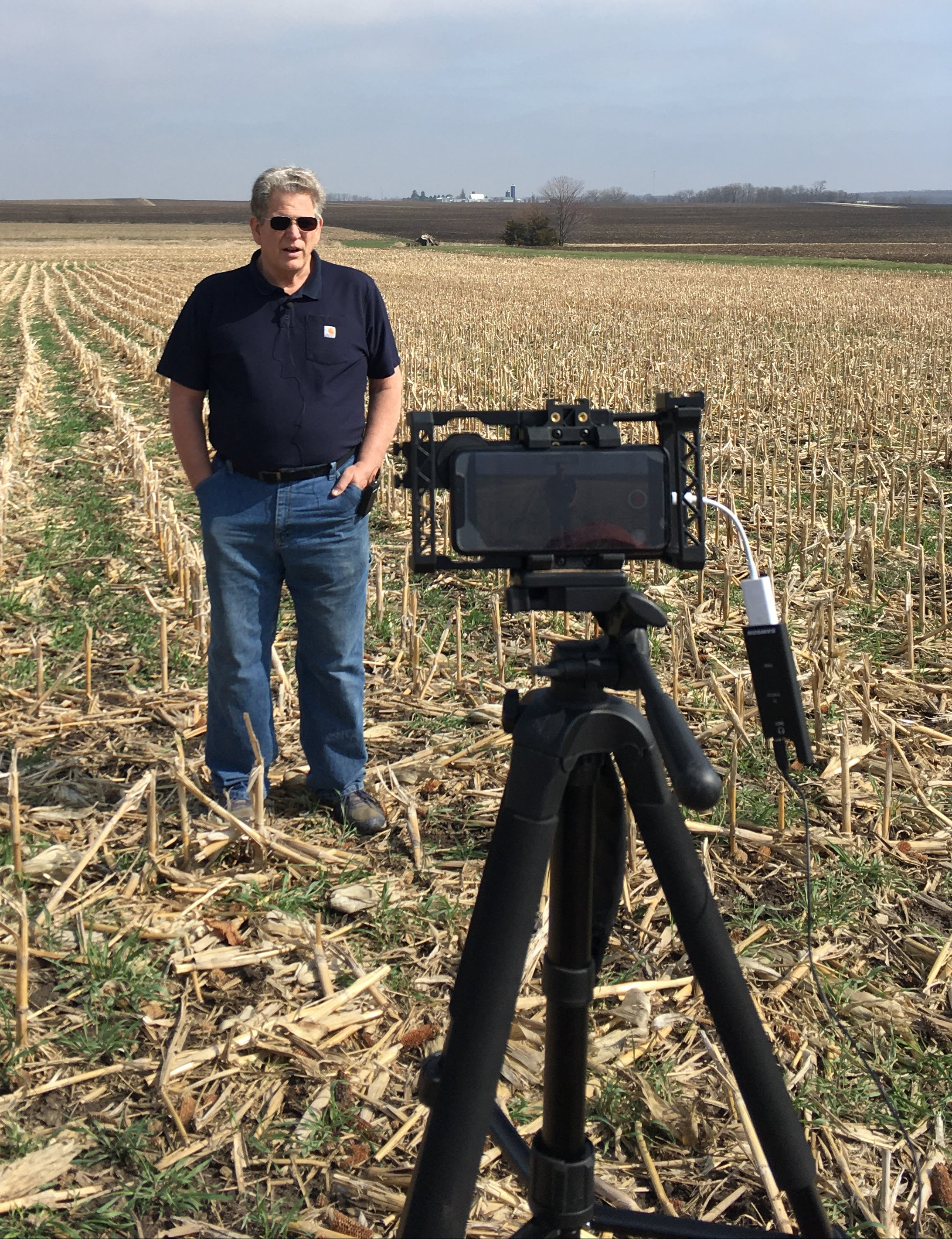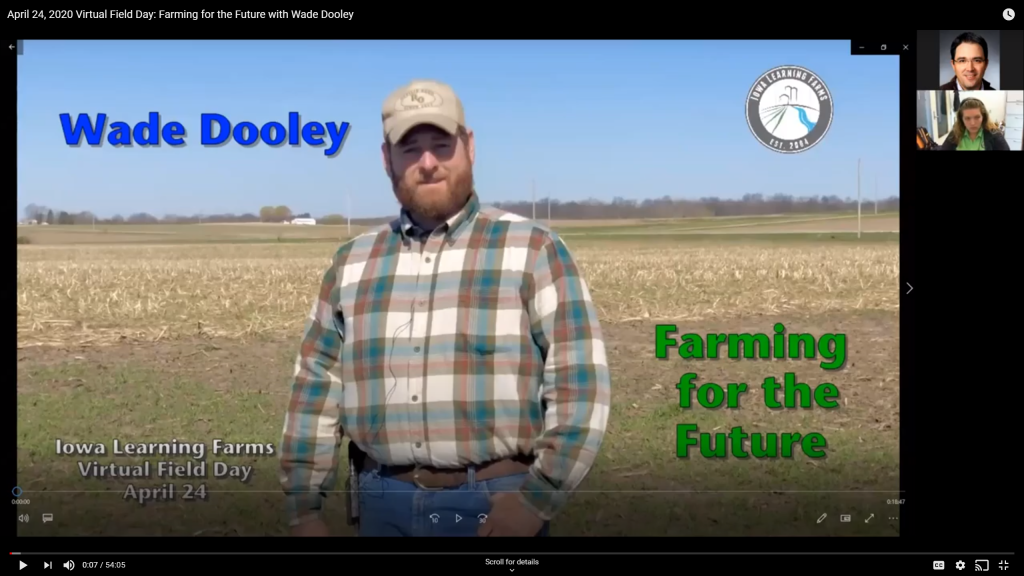
When plans for the spring series of field days were scrapped because of the coronavirus pandemic, the Iowa Learning Farms (ILF) team pooled their collective creativity and experience to quickly develop a method for effective delivery of a field day via online tools. With this effort, the ILF Virtual Field Day went from idea to reality in the space of a few weeks. And it worked out great!
The task came with some fundamental challenges; 1) How to generate content, 2) How to script and produce compelling and interesting programs, 3) Finding and using the right delivery platform, and 4) Technology.
ILF program director Jacqueline Comito, proposed the idea of interleaving short video segments with live commentary and discussion between the virtual meeting host, presenters, and the audience to help keep the audience engaged and the program moving. Understanding that an audience watching on computer screens does not have the same attention span as one gathered on a farm, the virtual events would only run one hour.
These video segments would also provide a great deal of flexibility by transporting the audience to multiple sites without getting their boots muddy.
Getting the Content
As you all know, Iowa can be fairly windy, so getting good sound quality while outdoors can be challenging. After a few early experiments that failed, Comito settled on using her iPhone X with a Beastgrip Pro, tripod, Samson wireless microphone system, and Lightning-to-USB camera adapter. This combination delivered excellent video and audio quality, and provided production agility, enabling quick set up and tear down in multiple locations around the farm. The wireless microphone also facilitated social distancing for all participants in each shoot.

A helpful tip is to shoot more video and b-roll (video without a presenter which is used in editing to smooth transitions and add interest) than you think you could possibly use. This simplifies editing offers more options for creativity.
Production and Editing
Our video production goal is producing multiple visually meaningful video segments to reinforce the live presentation content. Just like agenda items for an in-person field day, each video segment contributes to the flow of the field day and must have a clear purpose. The videos bring the field to the virtual audience in ways that cannot be done with still photographs. Cutting together shots of the presenter speaking with close-ups or b-roll showing what they are talking about will keep the audience hooked and visually reinforce the message.
Since no one on staff had days to dedicate to the editing of the video material, we needed an editing program that was simple to use with professional features and a reasonable price. With this in mind, we selected Movavi. It is intuitive for beginners yet has some nice advanced features for people with more experience and time.
Delivering the Program
We chose Zoom as the delivery platform. A major advantage of Zoom is its integrated participant registration. ILF offers CCA credits to participants, but must have appropriate registration records to validate submissions. Registration also provides us with a ready-made list for sending follow up evaluations – a hallmark of the ILF program and fundamental tool for assessing the success of the event.

We have also experimented with different approaches during the live event to encourage natural and dynamic interactions between presenters and participants. These field days are not meant to be a one-way presentation such as a webinar, but an opportunity for discussion and back-and-forth conversations. We actively encourage participants to ask questions directly or through the Zoom chat feature. However, we have learned that it is more effective for a field day host to read the questions to the presenters to keep the conversation flowing.
Technical Lessons Learned
Moving quickly while breaking new ground, we ran into some technical challenges with the virtual field day productions. Things such as the recording issues noted earlier were quickly resolved. Others took more experimentation and research. Immediate and survey feedback was crucial in helping us understand and resolve the issues.
Despite performing technology tests before each of first two events, we got feedback that the video was choppy, and the motion didn’t sync with the sound. We consulted experts and tested multiple configurations before finding what we believe to be the golden ticket for reliably delivering the program. It certainly isn’t point-and-click, but it delivers the result we want.
- Record at 720p and compress during the export process
- Upload the video to YouTube
- Embed YouTube video into PowerPoint
- Share PowerPoint screen via Zoom using a dual monitor computer set up
A word of caution – when streaming YouTube embedded in PowerPoint, the screen sharing host cannot click anywhere while the video is playing. If they do, it will cause the video to stop and will resume at the beginning of the video when they hit play. So be sure to mute and turn off the host camera before hitting that play button!
Assessing Success
After getting past all the technical parts of virtual field days, we are left with two additional challenges: 1) Assessing the educational impact of the event, and 2) Reaching more farmers and producers. As with the technical side, we are experimenting with effective evaluation and promotion practices.
Adapting our standard field day survey strategy to the virtual environment, we send a brief online survey to all participants immediately after the event using Qualtics XM. An email reminder is sent one week later. Response rates to the three virtual field day evaluations have been about the same as we typically receive for our standard two-week evaluations.
We are actively working to increase participation from farmers and landowners by sending direct mail and electronic invitations to field day participants from the past three years. We hope that by reaching out directly, we will be able to encourage increased participation in future events.
As we continue to improve the virtual field day experience, we are excited about the positive feedback we’ve heard. Virtual field days will not replace in-person field days but the ability to visit multiple sites and opening attendance to those beyond driving distance make them a good addition to the full outreach program. We do look forward to getting back into the fields. Until then, stay safe and we look forward to seeing (or hearing you) online!
– Jackie Comito and Liz Ripley
One thought on “ILF Scores Quickly with Virtual Field Days”
Comments are closed.